إن الخروج بفكرة مشروع رائد يمكن أن يحقق نجاحًا باهرًا لشركتك أمر مثير! ولكن قبل الانغماس في تحويلها إلى واقع ملموس، من المهم التوقف قليلاً وتقييم جدواها. هل يمكن لهذا المشروع أن ينجح حقًا؟ هل لديك الأدوات والموارد اللازمة؟ هل تستحق النتائج الاستثمار؟
أدخل دراسة الجدوى - وهي المفتاح للإجابة على هذه الأسئلة الهامة وتشكيل مصير مشروعك.
في هذه المقالة، سنتعمق في عالم دراسات الجدوى. سنزودك بكل ما تحتاج إلى معرفته حول إجراء دراسة الجدوى وتحديد ما إذا كان مشروعك يمتلك ما يلزم لازدهاره. 🌷
ما هي دراسة الجدوى؟
تختبر دراسة الجدوى ما إذا كان المشروع المقترح قابلاً للتنفيذ وتقيّم فرص نجاحه. أثناء القيام بهذه الدراسة، يجب عليك تحديد أهداف المشروع , الخوض في أبحاث السوق وتحديد الموارد والميزانية اللازمة لتنفيذ المشروع بنجاح.
بعد الدراسة، يحدد المسؤولون التنفيذيون أو المستثمرون أصحاب القرار ما إذا كان المشروع يجب أن يحصل على الضوء الأخضر بناءً على تحليل الجدوى. ✅
تكمن أهمية دراسة الجدوى فيما يلي:
- تحديد ما إذا كانت الشركة أو الفريق أو المؤسسة قادرة على الوفاء بوعودها ضمن إطار زمني معقول
- منع الشركة من القيام بمشاريع محفوفة بالمخاطر
- تقديم تفاصيل عن عمليات الشركة والتحديات المحتملة والمنافسين ومصادر التمويل وتخصيصها
ما هي فوائد دراسة الجدوى؟
تقيّم دراسة الجدوى ما إذا كان مشروعك أو منتجك قابلاً للتطبيق ولديه القدرة على النجاح. تشمل الفوائد الرئيسية للحصول على تقرير دراسة الجدوى ما يلي:
- تقييم المخاطر: يساعد علىتحديد المخاطر المحتملة والتحديات التي قد تنشأ أثناء تنفيذ المشروع حتى تتمكن من تخفيفها في الوقت المناسب
- تقييم التكلفة: يساعد في تحديد ما إذا كان المشروع قابلاً للتطبيق من الناحية المالية وما إذا كان العائد المحتمل على الاستثمار يبرر النفقات
- تخصيص الموارد: يساعد فيتحديد الموارد اللازمة-البشرية والمالية والتكنولوجية- اللازمة للمشروع، مما يساعد فيتخصيص الموارد وإدارتها بفعاليةوالجدوى المالية الإجمالية
- الجدوى القانونية: يفحص الجوانب القانونية مثل الامتثال للقوانين واللوائح والتصاريح وأي عقبات قانونية محتملة
- الجدوى التشغيلية: تقييم ما إذا كان المشروع قادراً علىتلبية احتياجات المنظمة وإلى أي مدى
- جدوى الجدولة: يبحث فيالإطار الزمني للمشروعوتقييم ما إذا كان يمكن إكماله في غضون فترة زمنية معقولة ومقبولة
- جدوى السوق: يركز على فهم الطلب في السوق والمنافسة والعملاء المحتملين المناسبين لمنتجات أو خدمات المشروع
كيفية إجراء دراسة الجدوى في 7 خطوات سهلة
من أجل إجراء دراسة جدوى ناجحة، من الضروري اتباع الخطوات الصحيحة والتأكد من تحليل كل جانب بدقة. نحن هنا لنرشدك من خلال سبع خطوات بسيطة لتقييم الجدوى، مما يضمن استعداد مشروعك الكامل لإطلاقه الذي طال انتظاره. دعنا نلقي نظرة!
الخطوة 1: إجراء التحليل الأولي
قد يستهلك إجراء دراسة جدوى كاملة الوقت والموارد التقنية. بدلاً من الغوص مباشرة في التقييم، حاول غمس أصابع قدميك أولاً عن طريق إجراء تحليل أولي. فكر في الأمر وكأنه اختبار قبل الاختبار الكبير. 🤓
إليك أربع خطوات بسيطة لهذا الفحص الأولي:
- ابدأ بتحديد ما تريده من هذا المشروع وسبب أهميته لفريقك أو عملك
- ابحث عن المشاريع المماثلة في الخارج وانظر ما إذا كانت ناجحة أم لا
- اكتشف ما الذي يميز فكرتك - ربما فريقك أو موقعك أو التكنولوجيا التي تستخدمها
- حدد المخاطر من خلال وضع قائمة بالأشياء التي يمكن أن تسوء
بمجرد الانتهاء من هذا التحقق، ستفهم بشكل أفضل ما إذا كان الأمر يستحق التعمق في جدوى المشروع.
لجمع كل هذه المعلومات ومشاركتها بسهولة، يمكنك الاعتماد على انقر فوق -متجر شامل لجميع احتياجات أعمالك ومشاريعك! مستندات ClickUp ميزة ممتازة لجمع المعلومات في مستند واحد بحيث يكون كل شيء في متناول جميع أعضاء فريقك. يمكنك الكتابة والتعديل وترك التعليقات والتعاون في المستندات في الوقت الفعلي.
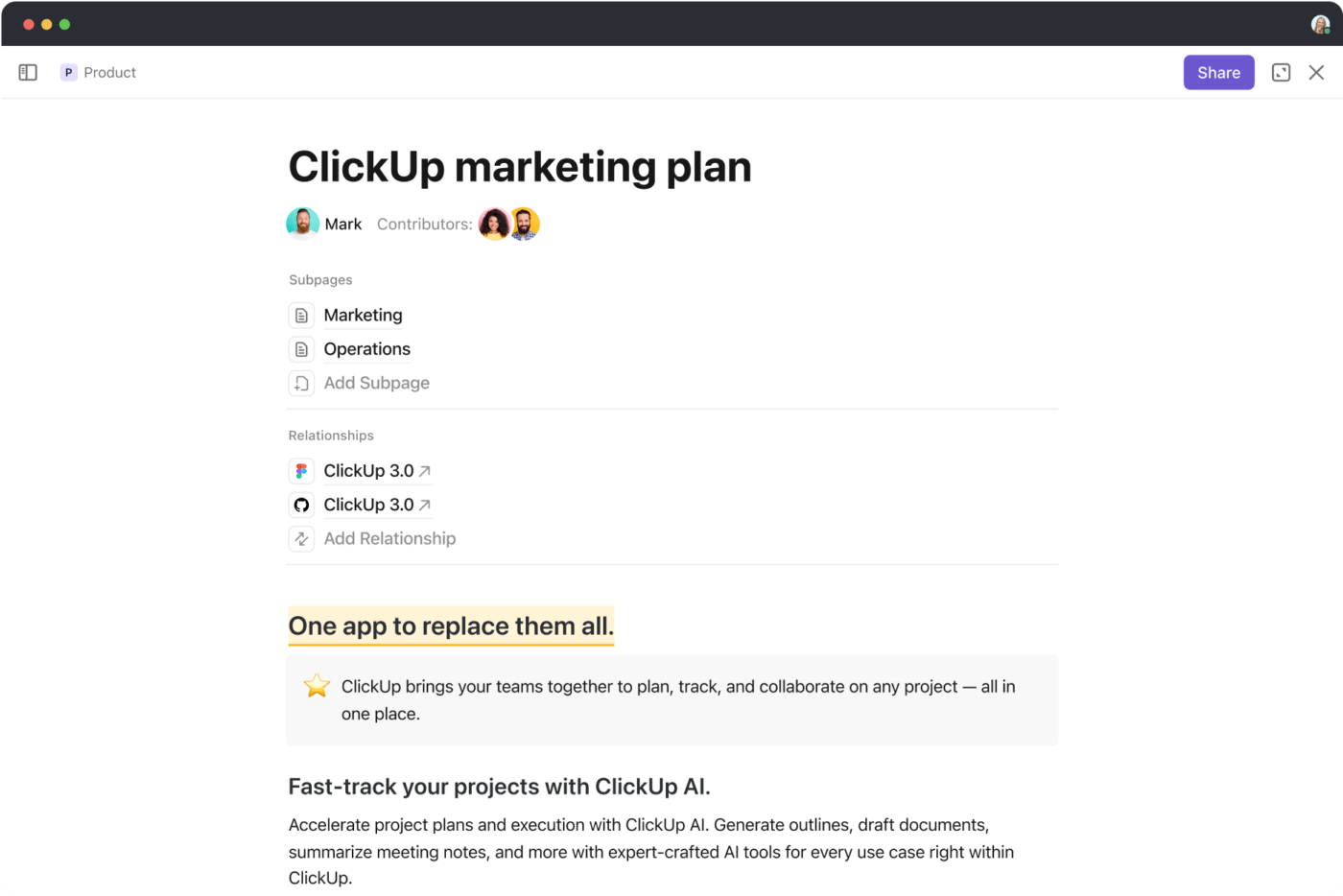
جمع البيانات وتحريرها بشكل تعاوني والتواصل في المستندات على الفور باستخدام ClickUp
هل تحتاج إلى تعيين المهام أو الإشارة إلى زملائك في الفريق؟ يمكنك القيام بذلك في المستندات بكل سهولة! بالإضافة إلى ذلك، يمكنك تعزيز مستنداتك بجداول وأقسام فرعية لضمان تقديم جميع البيانات بطريقة منظمة. 🎺
يمكنك أيضًا إنشاء صفحات فرعية مخصصة لكل مرحلة من مراحل التحليل الأولي دون عناء، مما يضمن تنظيمًا مبسطًا لجميع البيانات. علاوة على ذلك، يمكنك إنشاء روابط قابلة للمشاركة بسهولة وإدارة الأذونات بكفاءة لأعضاء فريقك وأصحاب المصلحة.
إذا كان البدء في إعداد تقرير جدوى من الصفر يبدو أمرًا شاقًا، يمكنك الاستفادة من قالب مخطط مشروع ClickUp ! إنه يقسم الأشياء إلى خطوات حتى لا تفوتك أي خطوة. 🥁
يحتوي على صفحات منفصلة لـ
- الأهداف
- الجدول الزمني للمشروع
- الميزانية والاستثمارات
- القيود والافتراضات
مثل جميع مستندات ClickUp، فإن القالب قابل للتخصيص بالكامل، لذا لا تتردد في إعادة تسمية الصفحات أو إنشاء صفحات جديدة لتتناسب مع احتياجات تحليل الجدوى الخاصة بك.
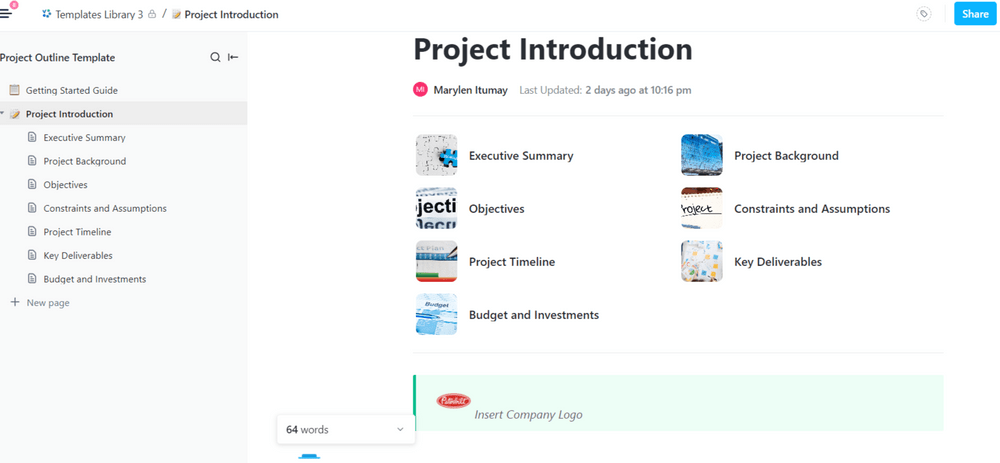
قم بتخطيط جميع تفاصيل مشروعك باستخدام قالب مخطط مشروع ClickUp
الخطوة 2: قم بعمل مخطط تفصيلي لنطاق المشروع
لتحديد تأثير مشروعك، يجب عليك تحديد ماهية المشروع. وهذا يعني الحصول على فكرة واضحة عن أهدافه ومهامه وتكاليفه ومواعيده النهائية. بالإضافة إلى ذلك، سيتعين عليك تحديد جميع المعنيين، من أصحاب المصلحة إلى العملاء والعملاء.
عندما يكون وقت العصف الذهني لا شيء يضاهي السبورة البيضاء القديمة الجيدة. إنها لوحتك للإبداع، والتنظيم المرمز بالألوان، والتأكد من أن الجميع على نفس الصفحة. ولكن إذا كنت تعمل عن بعد أو فرق مختلطة ، فإن قالب السبورة البيضاء لنطاق مشروع ClickUp هو الحل الأمثل! ✨
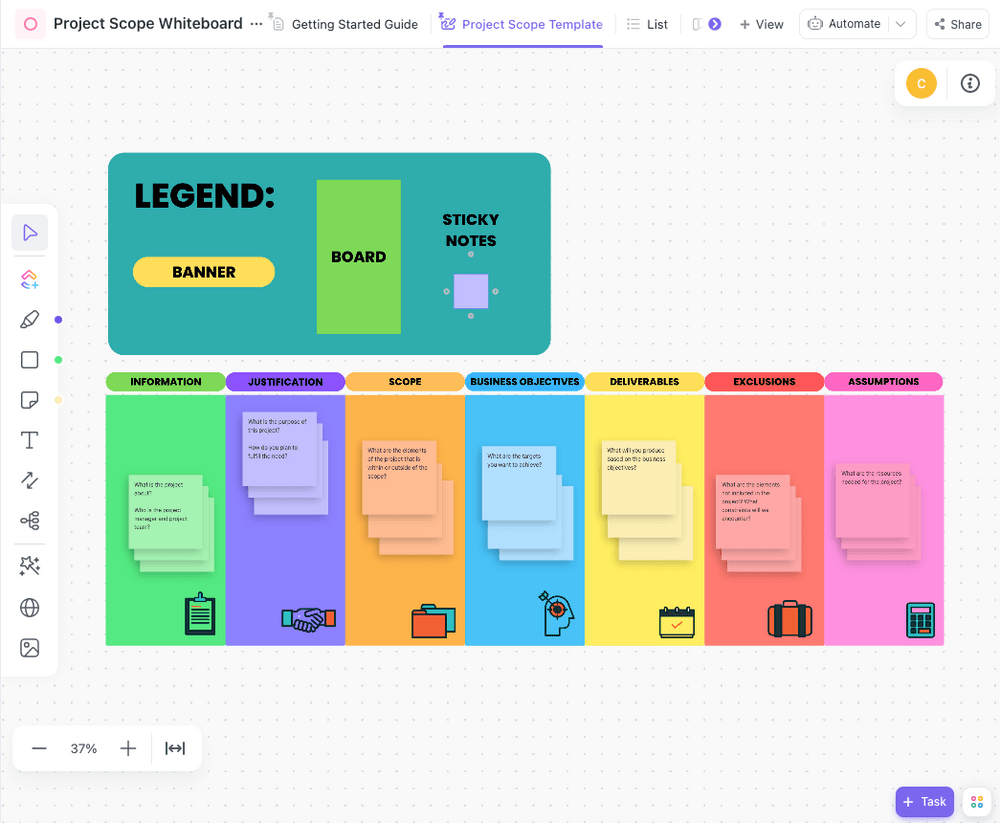
حدد بصريًا مسارًا واضحًا لنجاح المشروع من البداية إلى النهاية باستخدام قالب لوحة بيضاء لنطاق المشروع ClickUp
يحتوي هذا القالب على جميع مزايا السبورة البيضاء الفعلية ولكنه يقدم ميزات إضافية، مما يجعله أداة أكثر تنوعًا. يتضمن سبعة مكونات - المعلومات والتبرير والنطاق وأهداف العمل والمخرجات والاستثناءات والافتراضات.
لديك حرية تخصيصها من خلال:
- إضافة أو إزالة الملاحظات اللاصقة
- تضمين النصوص والروابط والملفات والصور والرسومات
- مشاركتها لـتعاون سلس 🤝
هذا ClickUp Whiteboard هي نقطة انطلاق رائعة لتنظيم مشروعك والعصف الذهني لعناصره الرئيسية. بالإضافة إلى ذلك، يمكنك تخصيصها عن طريق إضافة أو مسح أو إعادة تسمية العناصر حسب الحاجة.
الخطوة 3: إعداد بيان الدخل المتوقع
إن إعداد بيان الدخل المتوقع يشبه النظر في الكرة البلورية لعملك للسنة القادمة. فهو يخبرك بكل ما يتعلق بالإيرادات والنفقات المقدرة، وهو بمثابة أداة حيوية لاتخاذ قرارات مستنيرة بشأن الأعمال التجارية. تشمل العوامل التي تشكل هذا البيان ما يلي:
- الخدمات المقدمة
- رسوم الخدمة
- حجم الخدمة
- تعديلات الإيرادات
قم بإنشاء بيان دخل مخصص دون عناء باستخدام انقر فوق قالب دفتر الأستاذ العام ! اعتبر هذه الأداة المفيدة بمثابة مساعدك المالي. فهي تدير بسهولة بيان الدخل الخاص بك وكامل السجلات المالية لشركتك، وتبقى كمساعد قوي حتى بعد اجتياز مشروعك لتحليل الجدوى! 💪
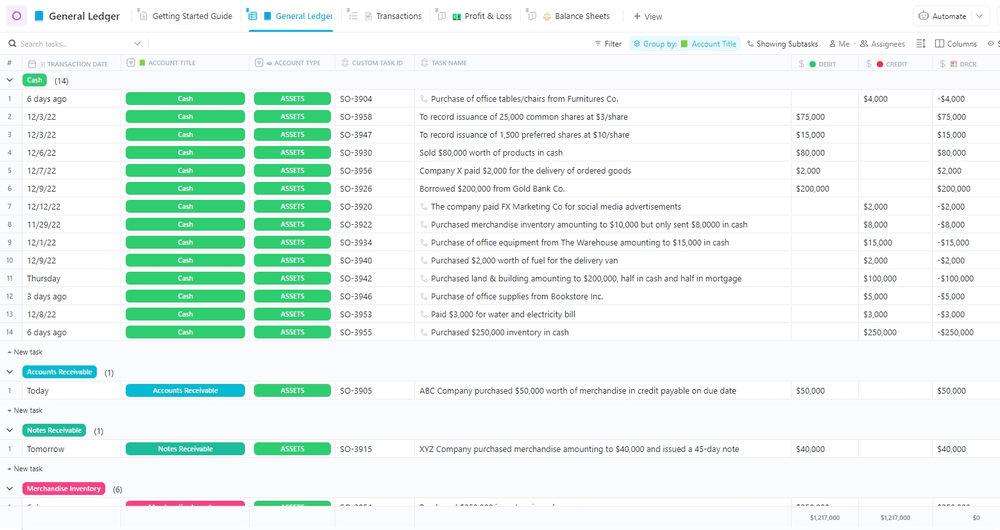
راقب معاملاتك المالية وقوائم الدخل الخاصة بك مع الحفاظ على تنظيمها بدقة مع قالب دفتر الأستاذ العام ClickUp
يأتي هذا القالب مع الحقول المخصصة مصممة خصيصًا لالتقاط كل تفاصيل المعاملات الدقيقة، بما في ذلك تواريخ المعاملات والإيصالات وأرقام القيد.
بعد تسجيل المعاملات، استفد من أربع طرق عرض رئيسية للمستند لإنشاء بيانات مالية متنوعة:
- طريقة عرض لوحة الأرباح والخسائر: يوفر لوحة نتائج مالية ويساعدك على تصور الإيرادات والمصروفات والأرباح من المعاملات المسجلة. يتيح لك تتبع العناصر وإعادة تصنيفها بسهولة عن طريق سحبها عبر اللوحة
- عرض لوحة الميزانيات العمومية: ترسم خرائط لأصولك وخصومك وحقوق الملكية في صورة واحدة مرتبةلوحة معلومات ClickUpالتأكد من بقاء سفينتك المالية في مسارها الصحيح
- عروض دفتر الأستاذ العام وقائمة المعاملات: يسمح بتتبع المعاملات اليومية مجمعة حسب عنوان الحساب أو معلمات أخرى
مع النظرة المالية الشاملة في القالب، سيتم احتساب كل التفاصيل. وهذا يمنحك الثقة في اتخاذ قرارات مالية دقيقة والتنقل بنجاح في تحليل الجدوى لمشروعك.
الخطوة 4: إجراء أبحاث السوق
تُعد أبحاث السوق أمرًا بالغ الأهمية لفهم ماهية ما يريده عملاؤك المحتملون ويحتاجونه مما يساعدك على فهم ما إذا كان هناك سوق لمنتجك أو خدمتك. كما أنه يتيح لك أيضًا تحديد حجم منافسيك وتحديد أفضل طريقة لوضع عملك التجاري في موضع النجاح. 🎉
هناك طرق مختلفة لإجراء أبحاث السوق؛ إحدى الطرق الشائعة هي إرسال استبيان للسوق. ClickUp AI يجعل إنشاء استبيانات أبحاث السوق أمرًا في غاية السهولة! استفد من قوته التوليدية السريعة لصياغة استبيانات مصممة خصيصًا لعلامتك التجارية وجمهورك في غمضة عين.
كل ما عليك فعله هو طرح الأسئلة الصحيحة واستهداف الجمهور المطلوب. ثم اترك الأمر لـ مساعد الذكاء الاصطناعي لتوليد اتجاهات مهمة والتفضيلات والآراء التي من شأنها تشكيل قرارات عملك .
بالحديث عن الذكاء الاصطناعي، يمكنك أيضًا إجراء بحث سريع عن السوق باستخدام ClickUp ChatGPT موجهات ClickUp ChatGPT لأبحاث السوق وقوالب التحليل ! تقدم هذه الأداة المفيدة مئات من مطالبات الذكاء الاصطناعي لإنشاء محتوى مفيد لتحليل اتجاهات السوق وتفضيلاته.
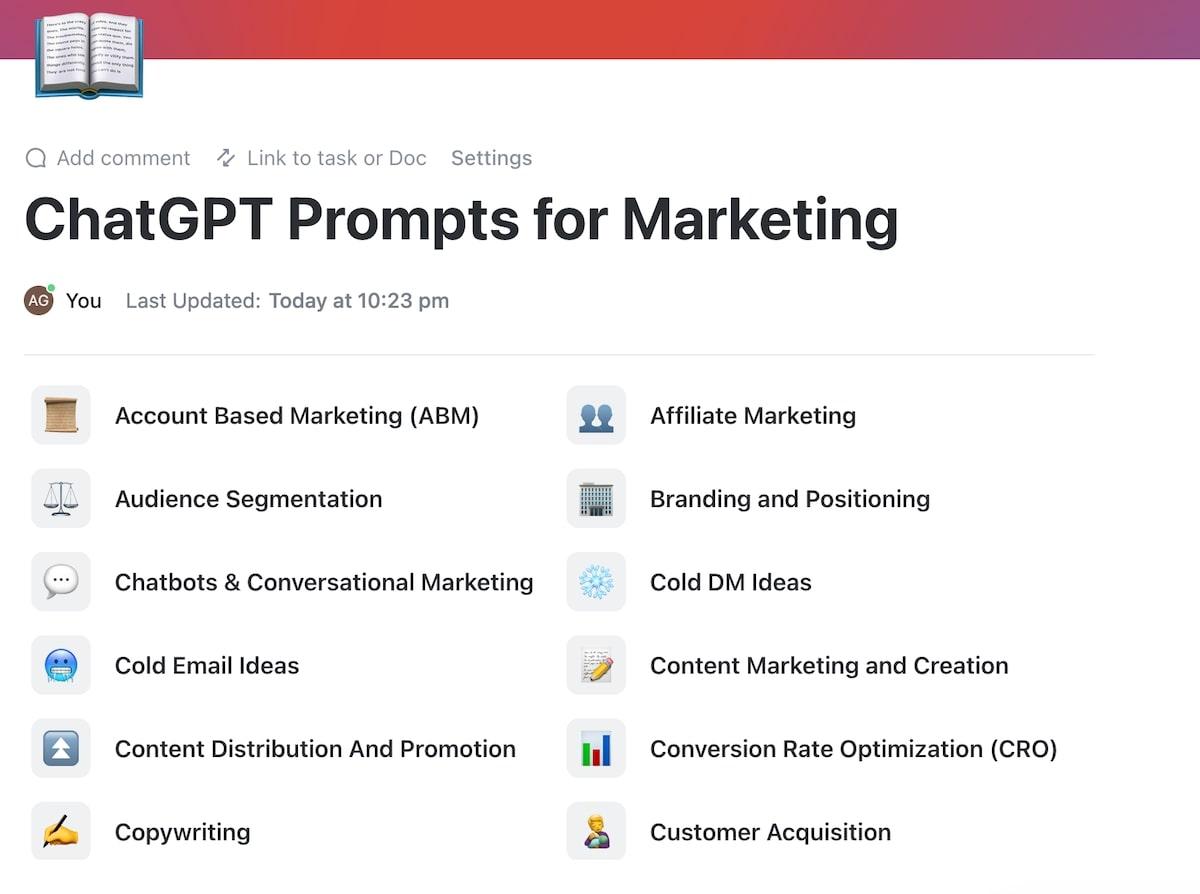
اطرح الأسئلة الصحيحة للحصول على رؤى سريعة حول اتجاهات السوق باستخدام قالب ClickUp ChatGPT موجهات ClickUp ChatGPT لأبحاث السوق والتحليل
لنفترض أنك بحاجة إلى معلومات عن أحدث اتجاهات الصناعة لاستراتيجيتك التسويقية. جرّب الموجه: هل يمكنك تقديم تقرير عن اتجاهات السوق والتنبؤات الخاصة بـ [أدخل الاسم] الصناعة لإثراء استراتيجية أعمالنا؟ وستحصل على النتائج التي كنت تبحث عنها في لمح البصر! ⚡
للتأكد من تغطية جميع الخطوات في بحثك ولا شيء ينزلق من خلال الشقوق، استفد من نموذج ClickUp لأبحاث السوق كما قائمة مهامك الشخصية .
يرشدك قالب المهام هذا إلى تعقيدات البحث، ويشمل منهجية البحث، وطرق جمع البيانات، والنتائج القيمة التي تم الحصول عليها من العملاء الحاليين أو المحتملين باستخدام الحقول المخصصة.
ضمن هذا القالب، تكون كل مهمة مصحوبة بقائمة مهام فرعية، مما يتيح لك مراقبة كل خطوة بحثية عن كثب. وتتضمن هذه المهام إجراءات حاسمة مثل تحديد نطاقات البحث وتجميع فريق بحثي بارع. 🕵🏼♂️
يمكن للمكلفين الإشراف بسهولة على التقدم المحرز في كل مهمة فرعية من خلال استخدام حالات مخصصة مثل مفتوحة، أو قيد المراجعة، أو مغلقة، مما يسهل عملية المراقبة.
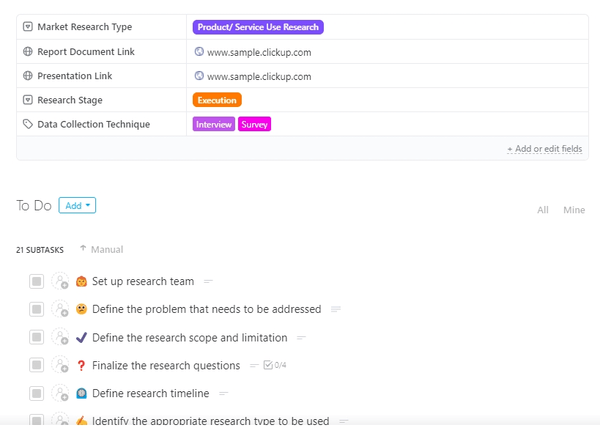
اتبع نهجًا منظمًا لتحديد من هو عميلك واحتياجاته باستخدام قالب ClickUp Market Research Template
الخطوة 5: إنشاء ميزانية عمومية افتتاحية لليوم الافتتاحي
واحدة من أذكى الطرق لجمع جميع أصولك وخصومك وحقوق الملكية هي البدء بميزانية عمومية افتتاحية. إنها بمثابة لمحة عن موقف شركتك فيما يتعلق بالموارد المالية والأصول عند إطلاق مشروع جديد أو مشروع تجاري جديد.
أولاً، أدخل جميع الأصول التي ستحتاج إليها لإدارة عملياتك بسلاسة. وهذا يشمل النقد للمصروفات اليومية، والمخزون، والمعدات، والممتلكات - جميع الأساسيات. بعد ذلك، ضع قائمة بالالتزامات مثل القروض وعقود الإيجار والمبلغ الذي ستحتاج إلى استثماره. قد يستغرق الأمر بعض الوقت، لكن الحصول على هذه التفاصيل يضعك على المسار المالي الصحيح.
هل تريد تخطي متاعب صياغة ميزانيتك العمومية؟ إن نموذج نموذج الميزانية العمومية ClickUp يدعمك! إنه يأتي محملاً بجداول وحقول جاهزة يمكنك تعديلها بتفاصيل الأمور المالية الخاصة بك، وها هي ميزانيتك العمومية جاهزة للعمل! 👌
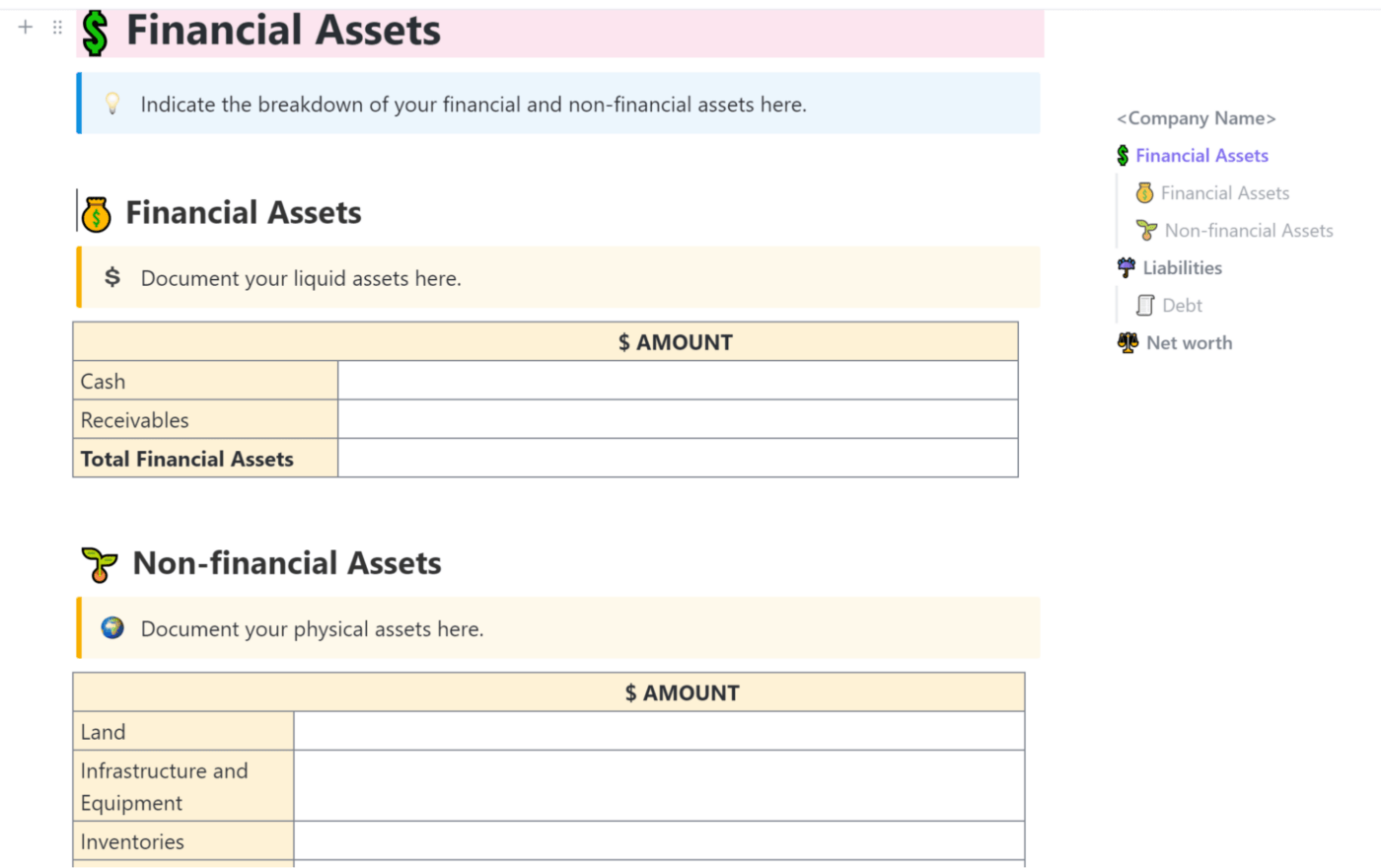
قم بتوثيق جميع أصولك وخصومك في مكان واحد باستخدام نموذج نموذج نموذج الميزانية العمومية ClickUp
يأتي قالب المستند هذا مع جداول مخصصة لـ
- الأصول المالية
- الأصول غير المالية
- الخصوم
- صافي القيمة
لا تتردد في إضافة المزيد من الصفوف والأعمدة لتناسب احتياجات عملك ومشاركة المستند مع الفريق بأكمله للحصول على ملخص مالي سهل.
الخطوة 6: مراجعة وتحليل جميع البيانات
الآن، خذ قسطًا من الراحة وراجع خطتك مرة أخرى. تضمن مراجعة الأمور وتحليلها أن كل شيء يسير على المسار الصحيح ولا حاجة لمزيد من التخصيص.
قم بمقارنة البيانات بمصادرها الأصلية و قم بمقارنة البيانات مع مصادرها الأصلية و أشر إلى أي تناقضات. إن الهدف الأساسي من دراسة الجدوى هو مساعدتك في اتخاذ قرارات أفضل، لذا يجب أن تدعم البيانات التي تجمعها تلك الخيارات.
يجب عليك مراجعة دراسة الجدوى من خلال النظر في الجوانب الإيجابية والسلبية للمشروع. عندما يتعلق الأمر بالتمويل، لا تدخر جهداً في توثيق جميع الافتراضات.
خلال هذه المرحلة، من الضروري تحديد المخاطر المحتملة ولديك استراتيجيات للتخفيف من حدة هذه المخاطر. يمكن أن يؤدي ذلك إلى نجاح أو فشل مشروعك - إذا كانت المخاطر التي ينطوي عليها المشروع تستحق المكافأة، فقد يحصل مشروعك على الضوء الأخضر. وإلا فقد ترغب في إعادة النظر في فكرة مشروعك.
تصور مشهد المخاطر في مشروعك باستخدام قالب لوحة تحليل المخاطر ClickUp ! حدد احتمالية وشدة كل خطر من مخاطر دراسة الجدوى الخاصة بك عن طريق وضع ملاحظات لاصقة على خريطة السبورة البيضاء المرمزة بالألوان.
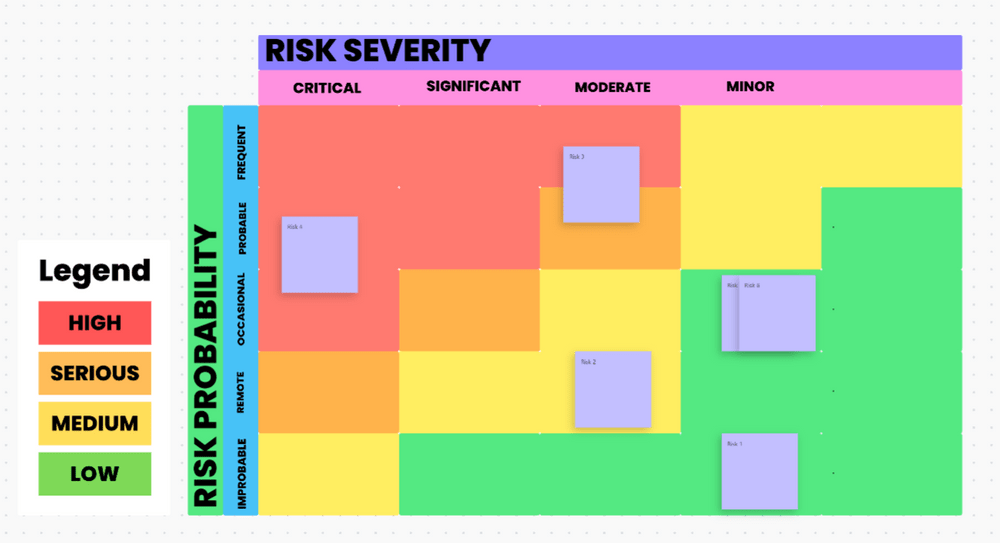
استخدم نهجًا مرئيًا لإدارة المخاطر باستخدام قالب لوحة تحليل المخاطر ClickUp لتحليل المخاطر
عندما تُصنف احتمالية وشدة المخاطر المحتملة على أنها عالية أو خطيرة، فقد يشير ذلك إلى الحاجة إلى إعادة التفكير في نهجك أو تبادل الأفكار مع فريقك لإيجاد حلول. وعلى العكس من ذلك، إذا كانت معظم المخاطر تندرج ضمن فئة متوسطة/منخفضة، فإن مشروعك يحظى بفرصة أفضل للحصول على الموافقة. 👍
الخطوة 7: الوصول إلى قرار الموافقة أو الرفض
تهانينا، لقد وصلت إلى اللحظة المثيرة التي تقرر فيها ما إذا كان المشروع سيحصل على الضوء الأخضر أم لا!
قبل اتخاذ القرار، الأمر متروك للعملاء أو أصحاب المصلحة المعنيين ليقرروا ما إذا كان المشروع يستحق وقتهم وجهدهم وأموالهم وما إذا كان يتوافق مع أهداف المؤسسة ذات الصورة الكبيرة. 🖼️
لتختتم دراسة الجدوى الخاصة بك، يمكنك الحصول على قالب الملخص التنفيذي لدراسة الجدوى ClickUp . استفد من تصميمه المصمم مسبقًا لتوفير:
- نظرة عامة على المشروع
- مشكلة مركزة
- الحل المقترح
بعد ذلك، تعمّق في أبرز ملامح المشروع - قم بإبهار أصحاب المصلحة من خلال تلخيص النتائج المهمة مثل تحليل السوق ونقاط قوة المشروع واعتمد على المخططات والرسوم البيانية للحصول على تلك اللمسة البصرية. 👊
استخدم الجداول المتوفرة لتدوين الموارد والجداول الزمنية واستراتيجيات النجاح الأخرى. أخيرًا، لا تنسَ التوقعات المالية - فالمخططات والرسوم البيانية مفيدة هنا أيضًا، حيث أنها سترسم صورة أكثر وضوحًا لقيمة المشروع مقابل المال.
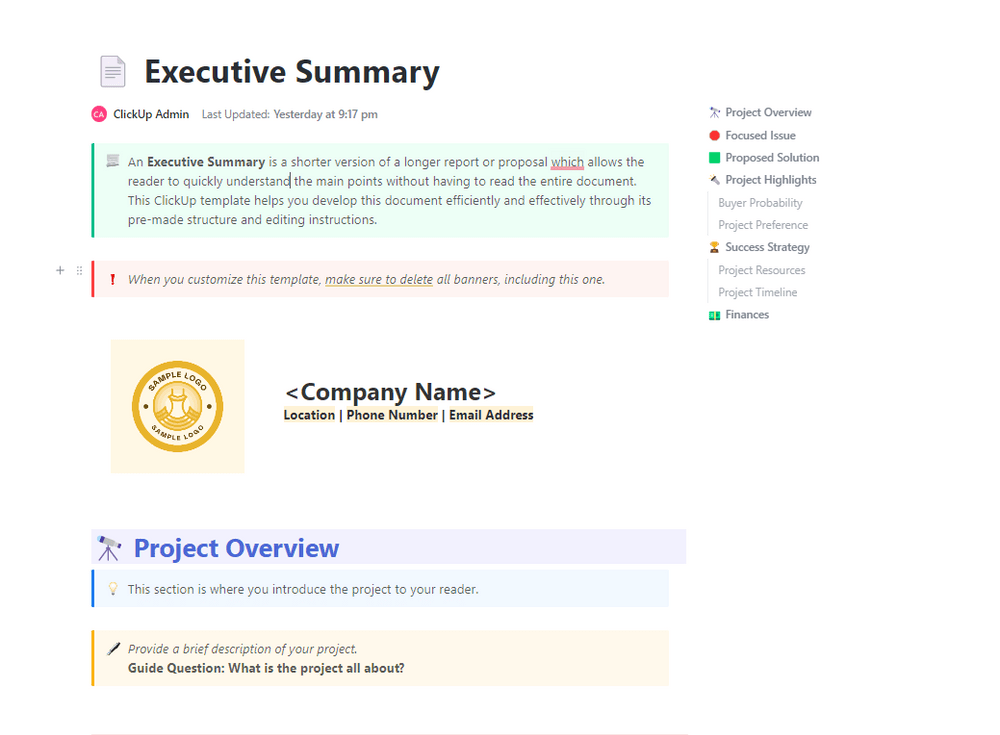
استفد من قالب الملخص التنفيذي لدراسة الجدوى ClickUp للحصول على نظرة عامة منظمة لمشكلات المشروع والحلول والنقاط البارزة
إن تقديم كل هذه المعلومات بطريقة منظمة وبسيطة سيساعد أصحاب المصلحة على فهم فكرتك بشكل جيد ومنظم، مما يجعلهم رحلة اتخاذ القرار أكثر سلاسة.
قم بإجراء دراسة جدوى دون عناء مع ClickUp
لا يتم إجراء دراسة جدوى شاملة في لمح البصر. لكن التنقل فيها يصبح أكثر سهولة عندما تلتزم بهذه الخطوات الرئيسية الـسبع التي وضعناها وتستخدم أدوات إدارة المشروع المناسبة.
لرحلة سلسة من خلال أهدافك التحليلية, اشترك للحصول على حساب ClickUp مجانًا اليوم ! لا تساعد هذه الأداة الفعالة في كل خطوة من خطوات دراسة الجدوى فحسب، بل تعمل أيضًا كأداة شاملة معالج إدارة المشروع !
بمجرد أن يحصل مشروعك على الضوء الأخضر، ستحب استخدام كنز ClickUp الدفين من أدوات إدارة المشروع , a مكتبة تضم أكثر من 1000 قالب و العديد من أدوات التعاون للبقاء على رأس مشروعك كالمحترفين! 😎

